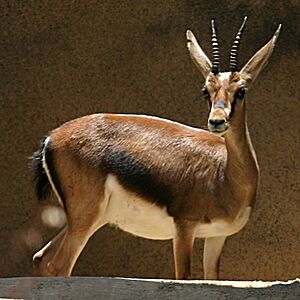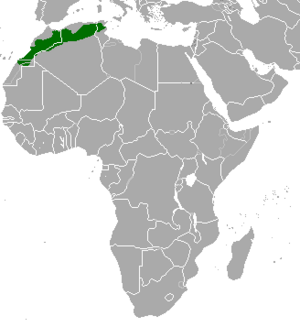Cuvier's gazelle facts for kids
Quick facts for kids Cuvier's gazelle |
|
|---|---|
 |
|
| At the San Diego Zoo | |
| Conservation status | |
| Scientific classification | |
| Genus: |
Gazella
|
| Species: |
cuvieri
|
The Cuvier's gazelle (scientific name: Gazella cuvieri) is a type of gazelle that lives in North Africa. You can find it in countries like Algeria, Morocco, Western Sahara, and Tunisia. People also call this gazelle the edmi. It's one of the darkest kinds of gazelles, which might help it blend in with its woodland habitat.
| Top - 0-9 A B C D E F G H I J K L M N O P Q R S T U V W X Y Z |
What Makes Cuvier's Gazelle Special?
Cuvier's gazelle is one of the smallest and darkest gazelle species. It stands about 60 to 69 centimeters (23 to 27 inches) tall. On average, it weighs around 35 kilograms (77 pounds).
Distinctive Features
This gazelle has a clear, wide, dark stripe along its sides. This stripe separates its brown back from its white belly. This coloring is called countershading. It helps the gazelle hide by making its body look flatter and less noticeable. They also have long, thin ears. Both male and female gazelles have horns. These horns are usually between 10 and 15 centimeters (4 to 6 inches) long. Male gazelles have horns that are more ribbed and thicker.
Where Do Cuvier's Gazelles Live?
Cuvier's gazelles live in the Atlas Mountains in Northwestern Africa. They can be found in many different types of places. They prefer sandy or rocky hills and flat areas called plateaus. You might also see them in young forests or thick pine forests.
Daily Routine
In the early morning and late evening, these gazelles come down from the mountains. They graze in the low grasslands, eating plants. Then, in the afternoon, they travel back up into the forests. They find a cool spot to rest and spend the hottest part of the day.
How Do Cuvier's Gazelles Behave?
Cuvier's gazelles usually live in small groups. During mating season, a group might have three or four gazelles, but usually no more than eight. These groups often include one male and up to three females, each with one or two young.
Social Life
When it's mating season, the strongest males will make younger males leave the group. These younger males then form their own groups, called bachelor groups. Later, the females will leave their group to give birth. After their babies are born, the females might join the bachelor groups for the rest of the mating season.
Staying Safe
Their main way to stay safe is by being very alert. If they sense danger, they send out an alert signal. They do this by flicking their tails and performing a special jump. This jump involves leaping into the air and landing all four hooves on the ground at the same time. Besides being alert, Cuvier's gazelles are also very fast. They can run at speeds over 50 miles per hour (80 kilometers per hour) for a long time.
How Do Cuvier's Gazelles Reproduce?
Cuvier's gazelles are pregnant for about 160 days. They usually breed in the winter and give birth in the early spring. Before giving birth, the mother gazelle leaves her group. She hides her newborn baby in thick bushes away from the others. She returns often to feed it milk. This continues for about a month until the baby starts eating plants. However, it still needs its mother's milk for a while.
Babies and Births
Cuvier's gazelle is one of the few gazelle species that often has twins. About 40.5% of births result in twins! Single babies weigh about 2.99 kg (6.6 pounds) at birth. Twins are a little smaller, weighing about 2.85 kg (6.3 pounds) each. Just ten days after giving birth, females can become pregnant again. This means they can have two sets of babies each year. Young female gazelles can become ready to have babies as early as 27 weeks old. They can give birth when they are about 70 weeks old.
What They Eat
Cuvier's gazelles are herbivores, which means they only eat plants. They are also ruminants. Their diet includes leaves, grasses, and other plants. They eat a lot of green plants. Then, they find a cool place during the day to finish chewing their cuds. Cud is food that comes back up from their stomach to be chewed again. This helps them digest their food better.
What is the Conservation Status of Cuvier's Gazelle?
In the past, the number of Cuvier's gazelles dropped a lot because of too much hunting. People hunted them for their skins, meat, and as trophies. By the 1930s, they were already considered very rare. But they weren't officially listed as endangered until the 1960s.
Current Challenges
Today, it is against the law to hunt these animals. However, they still face problems with their habitat. Local farmers sometimes destroy their living areas to create pastureland for their animals. Also, the gazelles have to compete for food with domestic sheep and goats.
Population and Protection Efforts
At one point, people thought the gazelle might be extinct in the wild. Now, it's believed that fewer than 2,000 Cuvier's gazelles exist. They live in small groups in the Atlas Mountains. Many of these gazelles live on protected land in Tunisia. However, this is not the case in Morocco and Algeria, where they still compete with livestock for food.
Djebel Chambi National Park in Tunisia is a very important safe place for them. It has the largest population in Tunisia. A program to reintroduce them was started in Tunisia's Jebel Serj National Park. In 2019, 30 gazelles were released there. These gazelles were born in Tunisia from a group originally from Spain. This reintroduced group has grown and is increasing.
In Algeria, the 200,000-hectare Saharan Atlas National Park is home to about a hundred Cuvier's gazelles. Belezma National Park has about 20, but this number is not certain. A plan to reintroduce more gazelles there is being considered.



